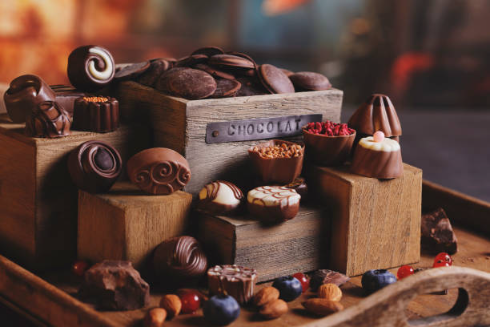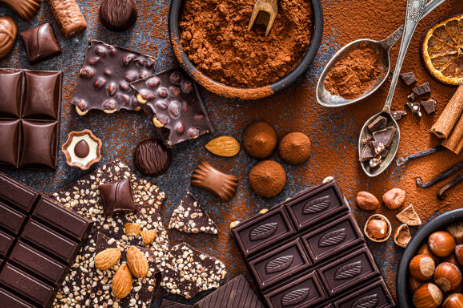When we think of “chocolate,” what usually comes to mind is the sweet, convenient candy bar. But chocolate didn’t start out this way—it was originally consumed as a drink.
A Quick History of Chocolate
Chocolate comes from the cacao tree, a tropical evergreen native to regions of Africa and Latin America. About 500 years ago, the Aztecs in present-day Mexico discovered this tree in the rainforests. They roasted its seeds to make cocoa powder and then mixed it with water to create a bitter, energizing drink—which they called chocolatl.
In the 16th century, the Spanish added spices and sugarcane juice to that cocoa drink, transforming it into something sweeter and more appealing. Then, in 1876, a Swiss innovator named Daniel Peter took it a step further: he mixed milk into the chocolate drink and created what we now know as modern milk chocolate. Not long after, solid chocolate was born when someone dehydrated the mixture and formed it into a bar—portable and easy to store, just like the chocolate we enjoy today.

Why Everyone Loves Chocolate
Scientific studies have shown that chocolate can:
-
Boost your mood
-
Improve focus and memory
-
Support cognitive function
-
Help maintain healthy capillaries
Combine those benefits with its silky, indulgent texture and it’s easy to see why chocolate is one of the most irresistible flavors on Earth.
Types of Chocolate (and When to Use Them)
Chocolate comes in many varieties, classified by cocoa content and added ingredients. The most common types include:
🍫 Milk Chocolate
Made by adding milk to dark chocolate. It’s smooth, sweet, and beloved by kids and adults alike. It’s also the most widely consumed chocolate globally thanks to its balanced flavor.
🍫 Dark Chocolate
Also known as “pure” or “bittersweet” chocolate, dark chocolate is rich in cocoa with little to no added milk. It has a bold, bitter flavor and a long-lasting aroma. While less popular among the general public due to its bitterness, dark chocolate is favored by purists and used in many premium products.
🍫 Chocolate with Nuts
Combining chocolate with hazelnuts, almonds, or walnuts creates a harmonious contrast between creamy and crunchy. It’s a fan favorite—think of it like a relationship: sweet but with a little texture and independence.
Specialty Chocolates and How to Use Them in Baking
Here’s a breakdown of chocolate types and the best way to use them in your baking adventures:
-
Unsweetened Chocolate: Perfect for recipes that call for intense chocolate flavor, such as fudgy brownies or chocolate fudge. Also great for making hot chocolate.

-
Bittersweet & Semisweet Chocolate: Ideal for brownies, cakes, or any dessert where you want a rich chocolate note. These melt beautifully for ganache, sauces, frostings, or fondue.
-
Cocoa Powder: Great for chocolate sauces, sponge cakes, or brownies.
-
Use natural cocoa powder when your recipe includes baking soda.
-
Use Dutch-processed cocoa powder for a milder flavor when no leavening agent is required. These two are interchangeable only if your recipe doesn’t involve baking soda or powder.
-
-
White Chocolate: Best for drizzles, glazes, and decorative accents. It’s smooth, sweet, and creamy.
-
Chocolate Chips: Excellent for folding into cookie dough, muffins, or scones. They add pops of chocolate without melting away completely.
-
Baking-Resistant Chocolate Chips (a.k.a. “high-temp” chips): These retain their shape even during high-temperature baking, perfect for breads or decorative fillings.
Tips for Working with Chocolate in Baking
-
Choose high-quality chocolate with a smooth, glossy surface and no white film or discoloration.
-
Keep your tools dry. Water is the enemy of melted chocolate—it will cause it to seize and become grainy.
-
Ideal melting room temp is around 64–68°F (18–20°C). Stir occasionally while melting.
-
Be patient when melting. Don’t stir too early. Wait until the chocolate is mostly melted, then stir gently with a heatproof rubber spatula to finish the job.
How to Store Chocolate Properly
-
Store whole chocolate bars or blocks wrapped tightly in plastic wrap in a cool, dry place—ideally between 54–64°F (12–18°C) with humidity below 65%.
-
For chocolate sauces or fillings, keep them in the refrigerator.
-
If stored improperly, chocolate can develop a whitish film or streaks called bloom. This won’t harm you, but it affects appearance and texture.
With so many chocolate varieties and uses, mastering how to choose the right one is a game changer for bakers. Whether you’re crafting the perfect ganache, folding chips into cookies, or topping a cake with a drizzle of white chocolate—knowing your chocolate makes all the difference.